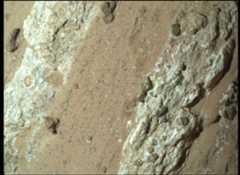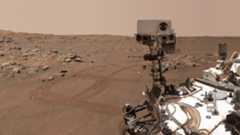
Mars
Mars is the fourth planet from the Sun, and the seventh largest. It’s the only planet we know of inhabited entirely by robots.
Mission Status
03
NASA Spacecraft in Orbit
02
NASA Rovers on the Surface
Featured Topics

Curiosity at 13
On Aug. 5 PDT (Aug. 6 EDT), the rover marks 13 years on the Red Planet.
Mars Overview
Mars is no place for the faint-hearted. It’s dry, rocky, and bitter cold. The fourth planet from the Sun, Mars is one of Earth's two closest planetary neighbors (Venus is the other). Mars is one of the easiest planets to spot in the night sky — it looks like a bright red point of light.
Despite being inhospitable to humans,robotic explorers — like NASA'sPerseverance rover andMars Reconnaissance Orbiter — serve as pathfinders to eventually get astronauts to the surface of the Red Planet.
COMET 3i/atlas
Interstellar Comet Cruising Toward Mars Flyby in Early October
Only the third known object to venture into our solar system from interstellar space, Comet 3I/ATLAS poses no threat to Earth, but is taking a tour past our celestial neighbors. NASA has been studying the icy visitor with space telescopes including Hubble, Webb, and SPHEREx. When the comet passes Mars on Oct. 3, multiple spacecraft there might catch a glimpse. The comet is on course to pass behind the Sun in late October, and venture past Jupiter in March 2026, on its way out of our solar system.
Learn More About Comet 3I/ATLASthe search for life
New Report: Perseverance Rock Sample Contains 'Potential Biosignatures'
A sample collected by NASA’s Perseverance Mars rover from an ancient dry riverbed in Jezero Crater could preserve evidence of ancient microbial life. Taken from a rock named “Cheyava Falls” last year, the sample, called “Sapphire Canyon,” contains potential biosignatures, according to a paper published Wednesday in the journal Nature.
Read 'NASA Says Mars Rover Discovered Potential Biosignature Last Year'
NASA's Perseverance Mars rover alongside the rock nicknamed "Cheyava Falls," in this July 23, 2024, selfie made up of 62 individual images. "Cheyava Falls," which has features that may bear on the question of whether the Red Planet was long ago home to microscopic life, is to the left of the rover near the center of the image. The small hole visible in the rock is where Perseverance collected the "Sapphire Canyon" core sample.
NASA/JPL-Caltech/MSSS
replay
NASA Shares Details of Perseverance Rover Finding
Experts discuss the analysis of a rock sampled by NASA's Perseverance Mars rover last year, and the science findings published Wednesday, Sept. 10, in the journal Nature. The sample, called “Sapphire Canyon,” was collected in July 2024 from a set of rocky outcrops on the edges of Neretva Vallis, a river valley carved by water rushing into Jezero Crater long ago.
Replay the Sept. 10 news conferenceThe mars Report
Meet the Mars Samples: Sapphire Canyon (Sample 25)
Meet the 25th Martian sample collected by NASA’s Mars Perseverance rover – “Sapphire Canyon” – a sample taken from a vein-filled rock named “Cheyava Falls.” The arrowhead-shaped rock contains compelling features that may help answer whether Mars was home to microscopic life in the distant past.
Learn More About 'Sapphire Canyon'How We Explore Mars
NASA has five active missions at the Red Planet and a future mission under study.

MARS SAMPLE RETURN | Future Mission
NASA and the ESA (European Space Agency) are planning ways to bring the first samples of Mars material back to Earth for detailed study.
Launch: TBD

PERSEVERANCE MARS ROVER | Active Mission
The Mars 2020 mission Perseverance rover is the first step of a proposed roundtrip journey to return Mars samples to Earth.
Launch:July 30, 2020 | 11:50 UTC
Mars Landing:Feb. 18, 2021 | 20:55 UTC

CURIOSITY MARS ROVER | Active Mission
Curiosity is investigating Mars to determine whether the Red Planet was ever habitable to microbial life.
Launch:Nov. 26, 2011 | 15:02 UTC
Mars Landing:Aug. 6, 2012 | 05:32 UTC

MAVEN | Active Mission
The Mars Atmosphere and Volatile EvolutioN (MAVEN) mission is the first mission devoted to understanding the Martian upper atmosphere.
Launch:Nov. 18. 2013 | 18:28 UTC
Mars Arrival: Sept. 22, 2014 | 02:24 UTC

MARS RECONNAISSANCE ORBITER | Active Mission
Mars Reconnaissance Orbiter searches for evidence that water persisted on the surface of Mars for a long period of time.
Launch:Aug. 12, 2005
Mars Arrival: Mar. 10, 2006

MARS ODYSSEY | Active Mission
Mars Odyssey mission created the first global map of chemical elements and minerals that make up the Martian surface.
Launch:April 7, 2001 | 15:02:22 UTC
Mars Arrival: Oct. 24, 2001
Why Do We Go?
Mars is one of the most explored bodies in our solar system, and it's the only planet where we've sent rovers to explore the alien landscape. NASA missions have found lots of evidence that Mars was much wetter and warmer, with a thicker atmosphere, billions of years ago.
Explore Mars with Usabout Why Do We Go?
Earth-Mars Comparison: This composite image, from NASA Galileo and Mars Global Survey orbiters, of Earth and Mars was created to allow viewers to gain a better understanding of the relative sizes of the two planets.
JPL
Mars Relay Network: Communications Bridge Between Mars & Earth
Mars Relay Network is the first link in a two-way communications bridge from Mars to Earth
NASA/JPL-Caltech/VTAD
Multimedia
Mars Resources
View the one-stop shop for all Mars iconic images, videos, and more!
Explore All Mars ResourcesNews & Features
Beyond the Moon
Humans to Mars
Like the Moon, Mars is a rich destination for scientific discovery and a driver of technologies that will enable humans to travel and explore far from Earth.
Mars remains our horizon goal for human exploration because it is one of the only other places we know in the solar system where life may have existed. What we learn about the Red Planet will tell us more about our Earth’s past and future, and may help answer whether life exists beyond our home planet.
Learn More About Humans to Marsabout Humans to Mars
Illustration of an astronaut on Mars, using a remote control drone to inspect a nearby cliff.
NASA
Featured Story
NASA Marsquake Data Reveals Lumpy Nature of Red Planet’s Interior
Rocky material that impacted Mars lies scattered in giant lumps throughout the planet’s mantle, offering clues about Mars’ interior and…
Read the Story
Keep Exploring
Discover More Topics From NASA
Mars Science Laboratory: Curiosity Rover
Part of NASA's Mars Science Laboratory mission, at the time of launch, Curiosity was the largest and most capable rover…

Mars 2020: Perseverance Rover
NASA’s Mars Perseverance rover seeks signs of ancient life and collects samples of rock and regolith for possible Earth return.

Mars Sample Return
Mars Sample Return would be NASA’s most ambitious, multi-mission campaign that would bring carefully selected Martian samples to Earth for…

Mars Exploration
Mars is the only planet we know of inhabited entirely by robots. Learn more about the Mars Missions.




































